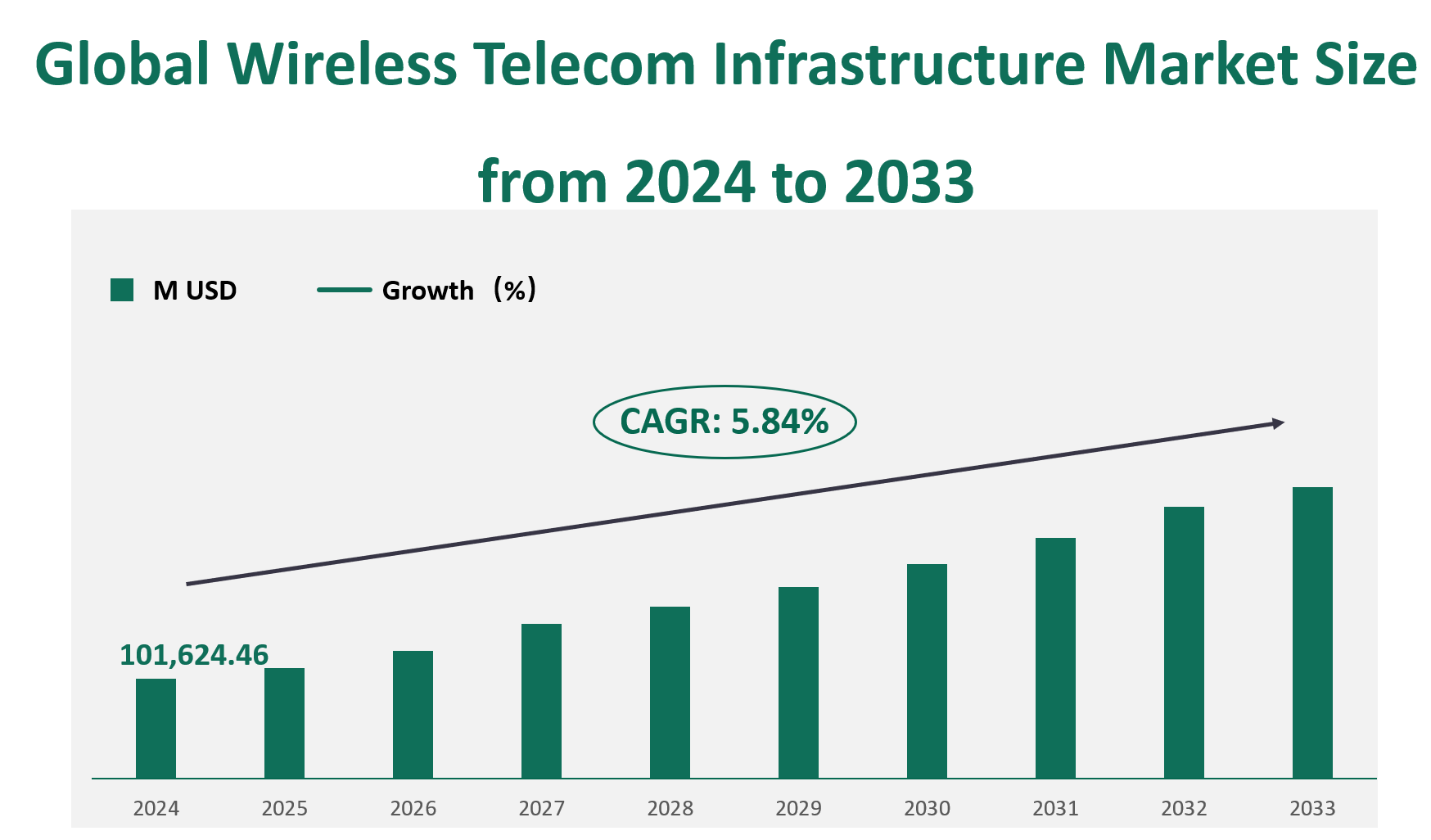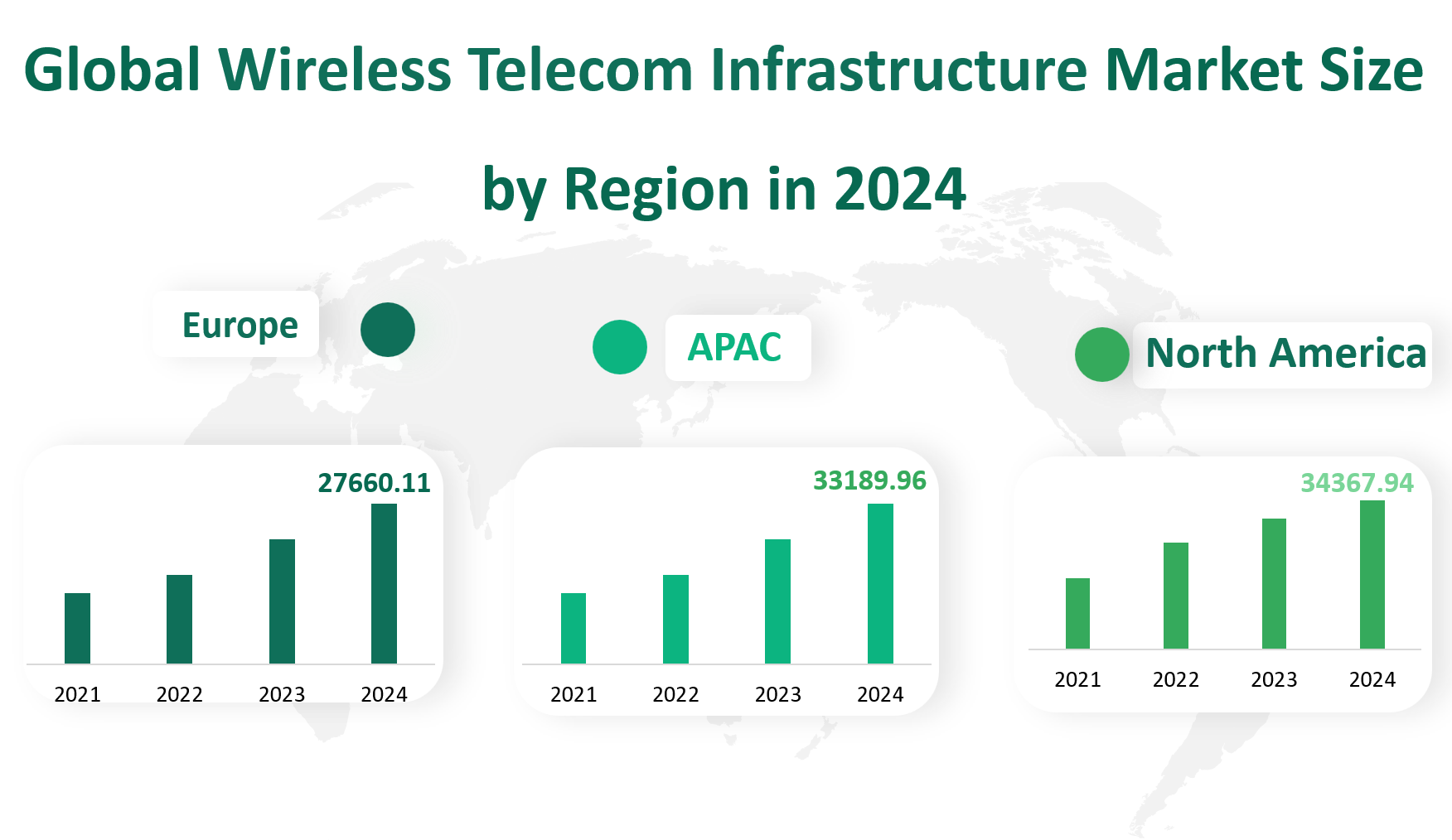1. Global Wireless Telecom Infrastructure Market Insight Analysis
The global Wireless Telecom Infrastructure market is projected to reach a revenue of 101,624.46 million USD in 2024, with a Compound Annual Growth Rate (CAGR) of 5.84% from 2024 to 2033.
Wireless Telecom Infrastructure refers to the underlying hardware, software, and network components that enable wireless communication services. This includes cellular towers, small cells, fiber optics, and other transmission equipment that facilitate the delivery of voice, data, and multimedia content over wireless networks. The market is segmented into various types, including Towers, Outdoor Small Cell, Indoor Small Cell, Site Development, Fiber, and Others. Each segment plays a crucial role in enhancing the capacity, coverage, and efficiency of wireless networks. For instance, towers provide extensive coverage areas, while small cells are designed to enhance network capacity in densely populated urban environments.
Figure Global Wireless Telecom Infrastructure Market Size (M USD) and CAGR (2024-2033)

2. Driving and Limiting Factors of Wireless Telecom Infrastructure Market Growth
The growth of the Wireless Telecom Infrastructure market is driven by several key factors. The increasing demand for high-speed data services, driven by the proliferation of smartphones and other mobile devices, is a primary driver. The advent of 5G technology, which promises faster speeds, lower latency, and greater connectivity, is also a significant catalyst. 5G networks require substantial investment in infrastructure to support their capabilities, thereby driving market growth.
Another driving factor is the increasing adoption of Internet of Things (IoT) devices, which rely heavily on robust wireless infrastructure for connectivity. The expansion of smart cities and industrial automation further fuels the need for reliable and high-capacity wireless networks. Additionally, government initiatives and policies aimed at improving digital infrastructure in both developed and emerging economies are providing a favorable environment for market expansion.
However, the market also faces several limiting factors. One of the primary challenges is the high cost of deploying and maintaining wireless infrastructure, especially in remote and rural areas. Regulatory hurdles and spectrum allocation issues can also impede market growth. Environmental concerns and public opposition to the construction of new towers and infrastructure are additional challenges that need to be addressed.
3. Technology Innovation and Corporate Mergers and Acquisitions in Wireless Telecom Infrastructure Market
Technological innovation is a key driver of the Wireless Telecom Infrastructure market. Companies are continuously investing in research and development to enhance network performance, reduce latency, and increase data transmission speeds. For example, the development of small cell technologies and distributed antenna systems (DAS) is aimed at improving network coverage and capacity in urban areas. Additionally, advancements in fiber optic technology are enabling faster and more reliable backhaul connections, which are essential for supporting high-speed wireless networks.
Corporate mergers and acquisitions are also shaping the market landscape. Major players in the industry are engaging in strategic partnerships and acquisitions to expand their market share and enhance their technological capabilities. For instance, CommScope’s acquisition of ARRIS International in 2019 aimed to strengthen its position in the wired and wireless communications market. Such strategic moves allow companies to integrate complementary technologies and services, thereby enhancing their overall competitiveness.
Furthermore, the market is witnessing increased collaboration between telecom infrastructure providers and technology companies. This collaboration is aimed at developing innovative solutions that can address the growing demand for high-speed, low-latency connectivity. For example, Huawei’s release of the 5G LampSite, a multi-band indoor small cell product, demonstrates the industry’s focus on delivering advanced wireless solutions.
4. Global Wireless Telecom Infrastructure Market Size by Type
The Wireless Telecom Infrastructure market is a complex and dynamic sector that plays a crucial role in modern communication systems. This market is segmented into various product types, each with its unique characteristics and market dynamics. The primary product types include Towers, Outdoor Small Cell, Indoor Small Cell, Site Development, Fiber, and Others.
Towers are the foundational structures of wireless telecom infrastructure. They are cellular-enabled mobile device sites where antennae and electronic communications equipment are placed, typically on radio masts, towers, or other raised structures. These towers create cells or adjacent cells within a cellular network, enabling wide-area coverage and connectivity. In 2024, the market revenue for Towers is forecasted to reach $54,863.02 million. Given their critical role in providing extensive coverage and supporting a large number of users, Towers have historically held a significant market share. They are essential for both urban and rural areas, ensuring seamless connectivity across vast distances.
Outdoor Small Cells are low-power radio access points designed for outdoor use. These devices have a lower radio frequency (RF) power output, footprint, and range compared to traditional macro cells. They are operator-controlled and can be deployed in licensed, shared, or unlicensed spectrum. Small Cells are particularly useful for improving coverage in densely populated urban areas, enhancing capacity, and supporting new services and user experiences. The market revenue for Outdoor Small Cells in 2024 is projected to be $12,294.22 million.
Indoor Small Cells are similar to their outdoor counterparts but are designed for indoor use. These devices are crucial for providing coverage within buildings, ensuring that users have reliable connectivity even in areas where external signals may be weak. Indoor Small Cells are particularly important for commercial buildings, stadiums, and other large indoor spaces where high data usage is common. The market revenue for Indoor Small Cells in 2024 is forecasted to be $7,239.98 million.
Site Development encompasses the planning, construction, and maintenance of telecom infrastructure sites. This includes everything from selecting suitable locations for towers and small cells to ensuring that the infrastructure is properly installed and maintained. Site Development is a critical aspect of the industry, as it ensures that telecom infrastructure can be deployed efficiently and effectively. The market revenue for Site Development in 2024 is expected to be $9,953.84 million.
Fiber-optic cables are the backbone of modern telecom networks. They provide high-speed, high-capacity data transmission, making them essential for both wired and wireless communication systems. Fiber infrastructure is used to connect towers, small cells, and other telecom equipment, ensuring that data can be transmitted quickly and reliably. The market revenue for Fiber in 2024 is forecasted to be $12,416.78 million. Given their role in supporting high-speed data transmission, Fiber networks are becoming increasingly important as data usage continues to grow.
Table Global Wireless Telecom Infrastructure Market Size by Type in 2024
|
Market Size (M USD) 2024 |
Market Share | |
|
Towers |
54863.02 |
53.99% |
|
Outdoor Small Cell |
12294.22 |
12.10% |
|
Indoor Small Cell |
7239.98 |
7.12% |
|
Site Development |
9953.84 |
9.79% |
|
Fiber |
12416.78 |
12.22% |
|
Others |
4856.62 |
4.78% |
5. Global Wireless Telecom Infrastructure Market Size by Application
The Wireless Telecom Infrastructure market serves a wide range of applications, each with its unique requirements and market dynamics. The primary applications include Data Processing, Communications, Public Safety, Automotive and Industrial Use, and Others.
Data Processing involves the collection, storage, and analysis of data within the telecom infrastructure. This application is crucial for managing the vast amounts of data generated by modern communication systems. Data Processing ensures that information is handled efficiently and securely, enabling seamless communication and data transmission. The market revenue for Data Processing in 2024 is forecasted to be $12,467.97 million.
Communications is the core application of the wireless telecom infrastructure market. It encompasses all aspects of voice, video, and data transmission between users. This application is essential for enabling seamless connectivity and communication across various devices and platforms. The market revenue for Communications in 2024 is projected to be $58,980.55 million.
Public Safety applications involve the use of wireless telecom infrastructure to support emergency services, law enforcement, and other public safety initiatives. This includes the deployment of dedicated communication networks for first responders, ensuring that they can communicate effectively during emergencies. The market revenue for Public Safety in 2024 is expected to be $8,347.76 million.
Automotive and Industrial Use applications involve the integration of wireless telecom infrastructure into vehicles and industrial systems. This includes the deployment of connected vehicles, smart factories, and other industrial applications that rely on wireless communication. The market revenue for Automotive and Industrial Use in 2024 is forecasted to be $15,983.85 million. As the Internet of Things (IoT) continues to grow, the importance of this application is expected to increase significantly.
Table Global Wireless Telecom Infrastructure Market Size by Application in 2024
|
Application |
Market Size (M USD) 2024 |
Market Share |
|
Data Processing |
12467.97 |
12.27% |
|
Communications |
58980.55 |
58.04% |
|
Public Safety |
8347.76 |
8.21% |
|
Automotive and Industrial Use |
15983.85 |
15.73% |
|
Others |
5844.33 |
5.75% |
6. Global Wireless Telecom Infrastructure Market by Top Regions
North America is expected to remain a key player in the Wireless Telecom Infrastructure market, driven by the United States’ dominant position and Canada’s steady growth. In 2024, the region’s market revenue is forecasted to reach $34,367.94 million USD. The United States, with its advanced technological infrastructure and high demand for high-speed wireless services, is the primary driver of this region’s market.
Europe is another significant market for Wireless Telecom Infrastructure, with a forecasted revenue of $27,660.11 million USD in 2024. The region’s market is characterized by a diverse mix of developed economies, each contributing to the overall growth. Germany, the UK, and France are key markets within Europe, driving the demand for advanced wireless infrastructure.
The Asia-Pacific region is poised to be the largest market for Wireless Telecom Infrastructure by 2024, with a projected revenue of $33,189.96 million USD. This region’s growth is driven by the rapid expansion of wireless networks in China, Japan, South Korea, and India. China, in particular, is a significant contributor to the region’s market revenue, with substantial investments in 5G infrastructure and smart city initiatives.
The Middle East and Africa region is expected to contribute $2,871.85 million USD to the global Wireless Telecom Infrastructure market in 2024.
South America’s market revenue for Wireless Telecom Infrastructure is forecasted to reach $3,534.60 million USD in 2024.
Figure Global Wireless Telecom Infrastructure Market Size by Region in 2024

7. Global Wireless Telecom Infrastructure Market Analysis by Major Players
7.1 Huawei
Introduction and Business Overview: Huawei is a leading global provider of information and communications technology (ICT) infrastructure and smart devices. Founded in 1987, Huawei operates in over 170 countries and serves more than three billion people worldwide. The company is known for its extensive research and development capabilities and its commitment to delivering advanced wireless solutions.
Products: Huawei offers a wide range of wireless telecom infrastructure products, including 5G networks, small cells, and advanced antenna systems. Its 5G LampSite, for example, is a multi-band indoor small cell product designed to support both 5G NR and 4G LTE, providing seamless indoor coverage.
7.2 Nokia
Introduction and Business Overview: Nokia is a global communications company with a long history dating back to 1865. The company offers a broad range of technological devices and software, focusing on creating critical networks and technologies to connect businesses, cities, and societies worldwide.
Products: Nokia’s product portfolio includes AirScale radio access solutions, dynamic spectrum sharing (DSS) software, and high-performance massive MIMO adaptive antennas. These products are designed to enhance network efficiency and support the transition to 5G.
7.3 Ericsson
Introduction and Business Overview: Ericsson is a Swedish multinational networking and telecommunications company founded in 1876. The company specializes in providing telecommunications equipment and related services to mobile and fixed network operators globally.
Products: Ericsson’s offerings include 5G base stations, fixed wireless access packages, and mission-critical networks. The company’s millimeter-wave Street Macro solution, for example, is a key product for North American customers, supporting high-capacity 5G networks.

